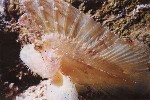|
Photos: The stonefish is a real challenge since its coloured fins are one of its main interests, but it only shows them when it flees, which it seldom does. I didn't want to disturb it, but my divemaster wanted me to see this. Otherwise, it allows one to move in very close. I was also able to spend quite some time with a paperfish, which hardly moved away when I came right next to it with my macro frame. Encounters with crocodile fish are rare, so I only managed to photograph an adult, without thinking of getting closer. It doesn't move at all as it relies on camouflage for hunting. The young one I saw in the sand didn't move at all. Scorpion fish are harder to photograph from close, but are often come across. I like to show these pictures and see if people can spot them out. Description: I've put in this category many masters of camouflage, which are much more common than one imagines. Hard to see, their appearance is a real proof of evolution and a constant challenge for divers. The most common one is the scorpionfish, which awaits its prey hidden amongst living or dead coral which inspires its colours and shapes. Its dorsal fin contains a poison as dangerous as that of the lionfish, but its venom is based and proteins which are unstable at high temperatures so any wound can be treated with boiling water. Much more rare and harder to spot, the stonefish is one of thos species that one completely ignores until someone shows you one. It prefers habitats which have the color of stone, hence its name as it resembles coral debris. It doesn't have bright colours like scorpionfish. Also venimous, it is less shy than the scorpionfish and can be approached to 10-15cm, as it tries to remain hidden but prefers to flee then. To make a stonefish move, you really have to want to, in particular to see its very bright fins, with ref, yellow and white with black spots, signaling the danger there'd be in eating it. Even more rare but more visible, because of its size, the crocodile fish lies on the reef waiting to gobble fish coming nearby. It only moves when provoked, and it not dangerous. I've only seen two adults, as well as a juvenile in the sand of a mangrove. Finally, the paperfish is less rare than it seems, as it is hard to spot and hides in holes. Motionless, or moving like a debri in the current, it only moves by small lazy jumps on its fins if annoyed, and resolves to swimming away a little if really upser. One can sometimes find several nearby, and I have only seen some on two occasions. Type | Max size | Habitat - Depth - Rareness - N/D- Comments | N | Stonefish | 15-20cm | | D | Scorpionfish | 30-40cm | | D | Crocodile fish | 50-60cm | | J | Paper fish | 8-9cm | | K |
|



